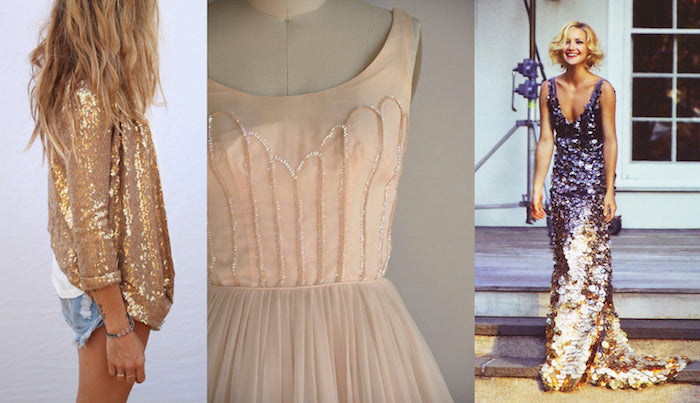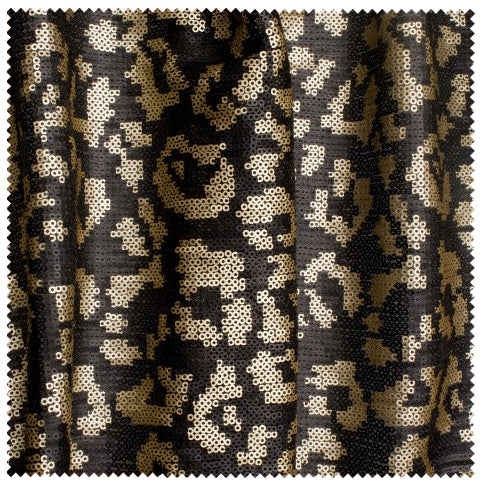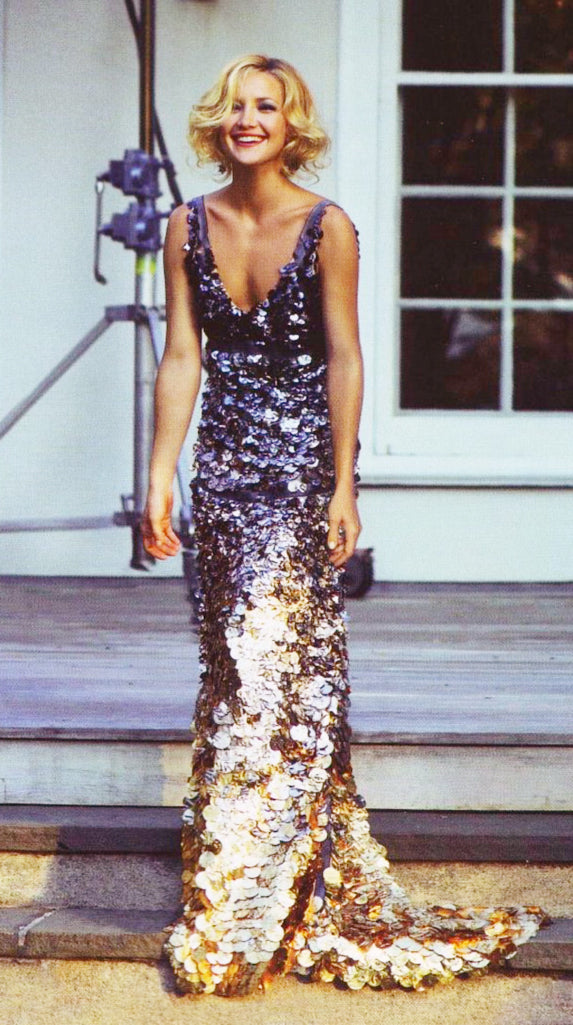
Since my last post on sewing with velvet, my interest in awkward fabrics is growing exponentially! I seem to have kicked off 2015 with an uncontrollable need to master the art of working with fabrics that I previously would have avoided like the plague. In the interest of documenting my findings and sharing some tips, I'm hoping this will turn into a little mini series that will shed some light on the more delicate, tricksy and unusual fabrics out there (suggestions always welcome!) Next up, sequins...
Before we get stuck in, I have to admit that it seems a little ambitious to be writing one single post about sequinned fabric, when it comes in so many different forms. In a nutshell, sequin fabric is fabric (woven, stretch or mesh) that little round (or square, or oval, or...) shiny plastic discs have been sewn or glued onto. For the sake of this tutorial, we're not going to cover fabric that has sequins glued on, as it doesn't really require the special treatment that sewn-on sequins do.
Types of sequin fabric: sequins sewn onto a non-stretch fabric
Fabrics such as organza, taffeta, tulle or mesh onto which sequins have been sewn. The woven, non-stretch kind of sequin fabric is most commonly used for dressmaking as it is well suited to designs that would be made from woven fabrics in general such as gowns, jackets, skirts and trousers. It is also excellent for embellishment details as it can be cut into a multitude of shapes and simply appliquéd onto other garments.
All-over sequins are stitched on in an organised overlapped row-by-row manner, all one colour or multicolour. They could even be two-tone - one colour if you brush them in one direction; a contrasting colour when you brush them in the opposite direction.

All-over sequins can also be stitched on in a more haphazard manner, or in a pattern.

Embroidered sequins are sewn onto the backing fabric more sparsely in intricate designs and patterns. As the backing fabric is usually pretty sheer, this type of sequin fabric is perfect for layering over other fabrics to create dreamy dresses or veils.

Types of sequin fabric: stretch sequins
Sequins that have been sewn onto a stretch fabric such as jersey, stretch tulle and mesh or elastic, usually in an all-over pattern. This type of sequin fabric is ideal for bodycon styles and dancewear/gymnastics.

All sequin fabric samples shown above courtesy of the wonderful Joel & Son Fabrics. Mouth-wateringly delicious, eye-wateringly expensive. Oh well, we can but dream...
Ideas & inspirations: sequin dresses
For those occasions when you want all eyes on you, the solution is always a show-stopping sequin number. But remember - let the fabric do the talking - avoid fussy details like pleats, pockets or gathers. Instead opt for simple designs and clean lines.

*
Giant ombré sequins and a big smile is all you need to stop traffic, as Kate Hudson effortlessly proves.

Kate Hudson in Prada, 2007
*
And of course, the sequin dress to end all sequin dresses... Show us how it's done, Mrs Rabbit.

*
Ideas & inspirations: sequin separates
Sequins aren't just for the red carpet. Layered with contrasting textures and prints, a casual sequin separate will transform even the dullest of corporate outfits, be your festival staple, and take you from daytime to partytime without a second thought.
The easy-chic of this summery blazer-vest-cut-offs outfit is so appealing. And completely achievable with our Victoria Blazer pattern...

*
Proof that a floor sweeping sequin skirt can be dressed down and passed most acceptably for weekend daywear. I love this.

*
Aaaaand further proof that a sequin maxi skirt can be totally casual and just the sort of thing you'd wear with a baseball cap to a brunch date (tip from the top: wait until the coffee and pancakes have been cleared before draping yourself over the booth).

*
Tailored jacket, cashmere sweater and sequin trews = babe in the boardroom.

*
Ideas & inspirations: sequin embellishments
If you're still not convinced that full-on sequins really are the bees' kneeses, then maybe I can entice you with a little something more on the subtle side...?
I'm absolutely smitten with the strikingly simple embellishment on this 1950s dress. Strings of sequins delicately hand stitched into place are anything but showy-offy.

*
Bored of your same-old same-old winter uniform of jeans and jumpers? I know I am. Easily updated with just a smattering of loose sequins...

*
A panel of sequin fabric stitched to the hem of a dress not only shakes things up a bit, but makes for the perfect remedy when you accidentally cut a hem obscenely short!

*
And finally, this sweet little sweater with sequin heart elbow patches. Maybe a little obvious and cheesy, but so what. Undeniably adorable.

*
Working with sequins: cutting & prepping your sequin fabric
Before you begin laying out your pattern pieces, the first thing to do is identify the "nap", or the direction of the sequins. It is of utmost importance that pattern pieces are cut so that the sequins all go the same way, and this is usually done so that the sequins face down. If you're using the super amazing fabric that has two-tone sequins, cut so that the colour you you want to show off the most is facing down.
Some sequin fabrics may not have a nap, for example those where the sequins have been sewn on in a haphazard sort of way (like the fabric I'm using), so you won't need to be as precise in terms of your "up" and "down".
Cut your pattern pieces from the wrong side, and from a single layer of fabric, as opposed to cutting pairs from folded fabric. Keep pattern pieces in place with weights and cut with a rotary cutter for best results.
For pattern pieces that require you to cut a pair, a bodice back for example, remember to flip your pattern piece over once you've cut the first side to avoid cutting two of the same.
When cutting a pattern piece that requires you to cut it on the fold, cut one side and then carefully flip it over, keeping that centre front line intact.
Warning! Watch out for renegade sequins shooting into your face as you cut - maybe even consider wearing a pair of glasses to protect your eyes.
Working with sequins: sewing & pressing
First things first, you'll be needing some extra sharp fine point needles for your machine - size 70 is ideal - and make sure that you have plenty spare!
Cut a scrap of your sequin fabric and put it aside. The spare sequins will come in useful if you need to hand sew a few on to cover up any bald spots near seam lines later on.
Before sewing, it's an excellent idea to mark out your seam lines with a contrast basting stitch - this is so that you can remove all the sequins that fall along the seam allowance, thus making the fabric easier to sew, less likely to break your machine needles, and preventing bulky seams. I found a seam ripper to be better than even teeny tiny scissors for removing sequins.
If your sequins are quite fine, you could try simply sewing through them as you would a normal seam. For this, I'd recommend using a stronger needle for your machine - a leather needle perhaps. You'll find that you get some sticky-out sequins that have been half-trapped in the seam - just snip these away carefully once it's all sewn up if need be.
When you come to pressing your seams, remember that sequins are plastic and likely to melt! Turn the heat down, press from the wrong side of your fabric, and use a presser cloth (a scrap piece of cotton for example) to protect your sequins.
To avoid irritating your skin, always line your sequin fabric makes with a fabric that's nice and easy to work with, and that's kind to your skin like cotton lawn or voile. A lining will also hide any raw seams, ridding you of the need for fiddly seam finishes.
Working with sequins: sewing with stretch sequins
First rule of thumb - avoid the temptation to use your overlocker/serger! The sequins will damage the knife and needles and it'll generally end up causing you a lot of unnecessary frustration. Instead, use the zigzag stitch. Other than that, all of the above also applies to stretch sequin fabric. When it comes to lining, choose a soft jersey that will match the stretch of the sequins.
Caring for your sequins
This may go without saying, but... Do not pre-wash! Dry clean only! In fact, just keep it away from your laundry room full stop!! Invest in professional after-care that reflects the level of pre-care that you put in in the first place.

As ever, if you have any tips or tricks for sewing with sequins of your own, please feel free to contribute in the comments below. Let's see if we can compile the definitive guide!









Comments on this post (46)
I am making a tulle skirt for my granddaughter and want to sew it onto an elastic sequined waistband but I am not sure how to sew the sequined elastic, can you please advise? Thanks.
— Linda Deans
Hi!
I was wondering if you have ever encountered all over sequins with an opaque/satin background and where might one find these for use in projects?
— James DuChatue
Hi Cynthia – You could do either, it depends on what kind of finish you would like. Sometimes had stitching, although it takes longer looks much nicer when done.
— Jessica - By Hand London
Hi Pia – Yes, you can sew darts on Sequin fabric as you would with any other fabric.
— Jessica - By Hand London
Thank you for this valuable " how to" on sewing sequin fabric. I am making a jacket to wear over a black crepe dress for NewYear formal ball and although I have been sewing for over 50 years I have never sewn allover sequin fabric before. Once again thank you xx
— judith manning
Thank you for explaining not only what to do with sequin fabrics but also the different kinds, like stretch sequins. I started a sewing class and I’ve been trying different fabrics so I wanted to try out sequin this time. Thank you for giving me ideas of how to use it, I’ll keep them in mind and refer back to them. https://bigzfabric.com/index.php/fabrics/sequins-fabric.html
— Liv Smith
Thanks for your valuable knowledge, and wisdom. I deemed it extremely useful.
However, I still struggle with the best practice for shorten a sequins dress. Please help.
Thanks in advance for your assistance.
— Geraldine Brown
I’ve taken on a challenging costume that is a lined leotard with sequined fabric. I need to add a zipper to the back (sequin fabric is very slightly one-way stretch). Any hints on how to go about this? Should I baste the two fabrics together and THEN attach the zipper? Feel free to e-mail me!
— Bridget
Creating a split on the front of evening gown made with sequin fabric and lined with jersey knit. Should I hand stitch the seam or machine stitch?
— Cynthia Pryer
I have just returned from Saigon, and purchased some amazing sequin fabric, however I am feeling a little daunted at all the measures required to sew it, your post though has helped, so here goes ?
— Barbara
Thank you for your helpful ideas. I am making a gown with 1" sequins and a lining. I have about 2 1/2 weeks. Lots of cleavage, form fitting and a long train. Short sleeves. It will still be hot. To be worn at 5 year renewal of wedding vows. Wish me luck and e-mail any more ideas you could share. Thanks, again for your great, helpful suggestions.
— Mel
This is a very helpful site. Trying to hand stitch a sequin glove(Michael Jackson type) with sequin fabric for my granddaughter. Very helpful hints, I’m glad I read into this. Crossing fingers, hope all goes well!
— Lolly
awesome way of looking at sequin, have also been running away from it but had the urge to do something daring this month and found myself reading this article and being inspired to try…you can only try, right?:)
— Eetea
I found it was easier to clip the sequins with nail clipper or slant cuticle clippers depending on the size of the sequin than using scissors when trimming the seam allowance.
— Diane Millington
Thanks so much i have turned away so many jobs of sequine dresses you have empowered me to give it a try. On myself first of course. I will be buying some goggles. thanks again
— Gail Galloway
Please wear glasses or goggles when you are cutting sequin fabric! A half cut sequin actually shot up into one of my eyes and it was quite frightening! It hurt too! I couldn’t get it our for a good ten minutes and I was in panic mode the whole time. Ever since then, I ALWAYS wear eye protection.
— katie k
If the patterns has darts, do you also sew darts on sequined fabrics?
— Pia
Very apt that I’ve just found this post! I’m finishing off a top made from the Kim dress pattern in a white sequin fabric to wear for my work christmas dinner this Friday…I should have removed the sequins in the seam allowances but was afraid to do so in case they started unravelling and shedding sequins along all the seam lines. Turning the sequinned back bodice pieces through Kim’s narrow shoulder straps was NOT fun, as you can imagine!!! Looks awesome though, so all worthwhile!!
— Junespoon
Hi Linda,
Sorry to hear this! I’m afraid there isn’t any tool that I know of to help you flip sequins quickly and efficiently… Are they the kind of sequins that flip easily when you run your hand over them? If so, and you don’t like the silver side, you may want to reconsider this fabric for your dress as they’ll be constantly changing side throughout the big day! If they stay put once they’ve been flipped to the white side however, then you’ll most likely be fine once the dress is done, but I don’t think there’s any quick way around getting them all there in the first place. Either way, make sure that the sequins are facing down when you position your pattern pieces – they’ll be less likely to flip back up that way.
I hope this helps!
~ Elisalex
— Elisalex - By Hand London
You mentioned two toned sequins. My wedding dress is supposed to be white sequins but the flip side is silver. The sequins are randomly flipped and it looks horrible. I am flipping them over one by one but it is so time consuming and seems like a lost cause because they so easily flip back to the silver side. Do you have any suggestions to keep the sequins from flipping and is there an easier way to flip them so they are all white side up? Is there any kind of tool that might work? I am imagining with horror my wedding pictures because the silver side makes the dress almost look like there are moth holes throughout. I am really at a loss as to what to do and quite desperate. Any help would be appreciated.
— Linda
I am so glad that I took time to read this article i am not a professional sewer but make costumes for a hobby and may first instinct was to use my overlocker I found this very useful and easy to understand I mean no jargon will definitely be looking out for more of your blogs
— Jerry Cannon-Moore
Thanks for this post! I had a hard time sewing a sequin dress recently. Taking the sequin from the seam allowance was taking way too long and I lost my patience lol. I just did a blog post about it. Check it out if you get a chance :)
— ChaCha N'Kole
Thank you for your help as I have been trying to overlock the edges of some dance costumes I am making. The overlocker copes with one layer of plain fabric and one layer of sequin, but when I try to move over where the darts are the needle instantly breaks, but then doesn’t seem to happen as badly when the plain fabric is on the top, only when the sequin fabric is. Why do you think this happens? I am going to go back to using the old sewing machine and zig zag like you suggested. Can’t be bothered trying different size needles. See how I go now. Thanks again.
— Jennifer
was looking for ideas on how to repurpose my daughter’s old dance costumes as she still wants to keep them – in some fashion. I love the idea above of the fabric skirt with sequined trim at the bottom. That may work perfectly for the old costume. Thanks!
— Lisa
Hi Anadeane,
I would hem sequin fabric in the same way as the seams – snipping away all sequins within the hemming allowance and then just fold up and hand stitch the hem into place. I hope this helps!
Elisalex
— Elisalex - By Hand London